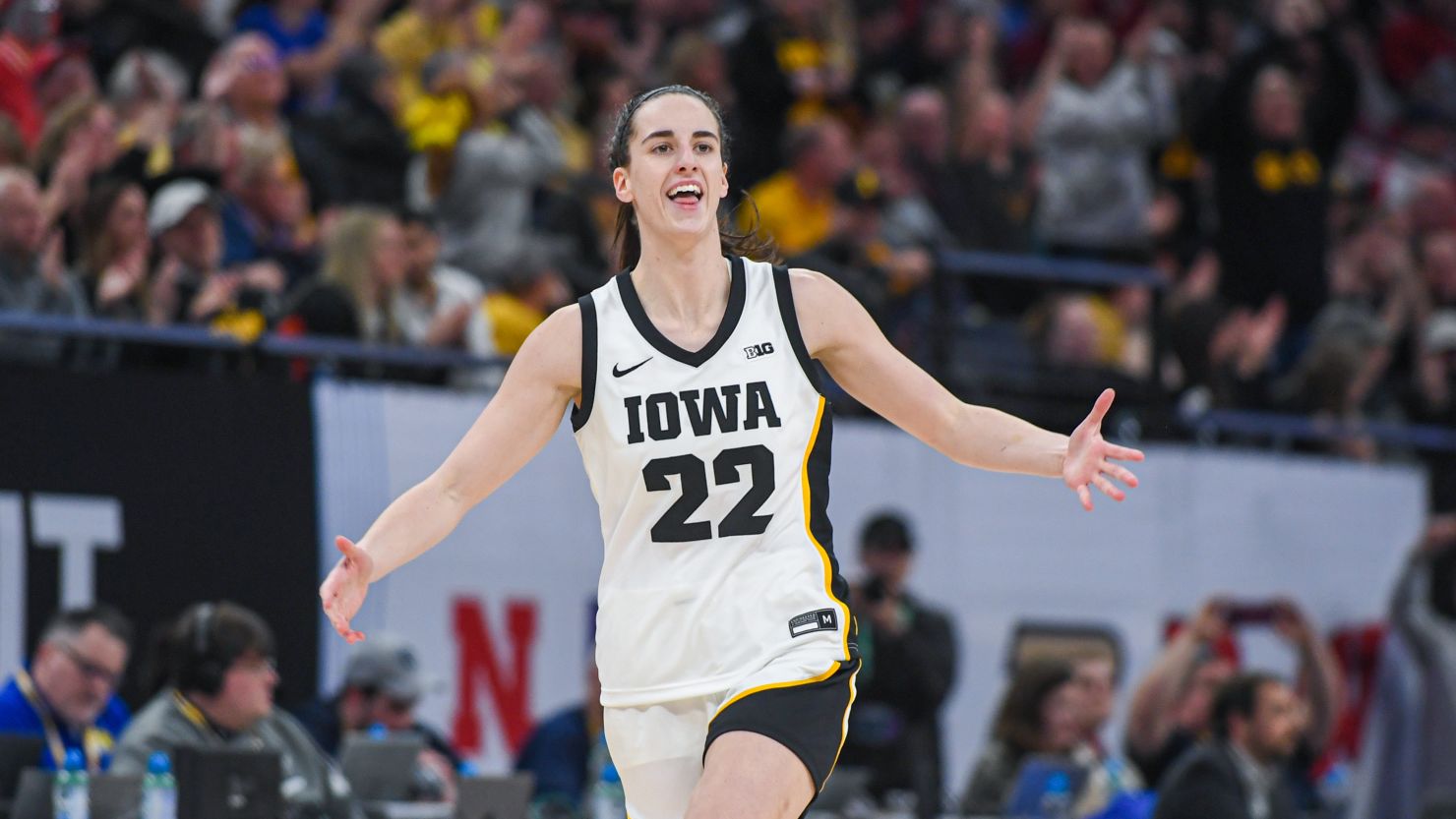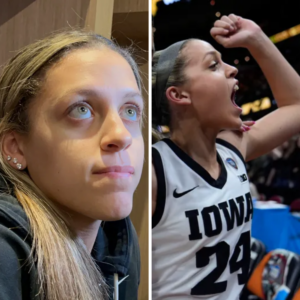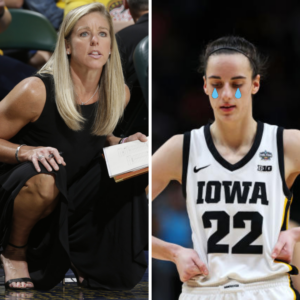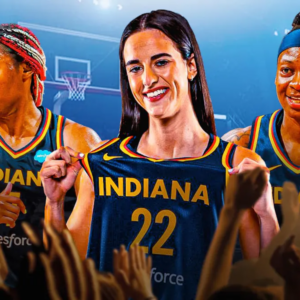
Caitlin Clark stands at center court in the Iowa Hawkeyes’ arena, captivating 15,000 fans in the arena and over three million viewers on television.
As she effortlessly sinks a free throw, followed by another, the crowd erupts in jubilation.
Last month, these routine points propelled Clark beyond the all-time college basketball scoring record, for both men and women, solidifying her status as a legend in the sport.
At 22, Clark’s remarkable talent has ignited a surge in interest in women’s basketball, particularly as March Madness unfolded.
NBA star Steph Curry hailed her record-breaking performance as “must-see TV” in a recent CBS interview, reflecting the sentiment of viewers nationwide.
This season, women’s college basketball has experienced one of its most successful regular seasons to date, with games averaging 476,000 viewers on ESPN platforms, marking a 37% increase in viewership.
Across all national networks, the audience for women’s college basketball has surged by over 60%, with a remarkable 48% increase on ESPN’s broadcasts, surpassing its male counterpart in average viewership, according to Michael Mulvihill, president of insight and analytics at Fox Sports.
Following the record-breaking ratings of Monday’s Elite 8 game against LSU, Iowa and Clark are set to face Connecticut in the Final Four on Friday evening.
Clark, a six-foot senior renowned for her shooting and passing skills, has undeniably been a driving force behind these impressive numbers, noted Jon Lewis, who has tracked sports ratings on his website Sports Media Watch since 2006. He likened her impact to that of transcendent stars like Curry, LeBron James, and Michael Jordan.
Clark’s statistics in her final season, which propelled her past Pete Maravich’s record, also draw comparisons to Curry’s standout performance in his last year with Davidson, with Clark averaging 31.9 points per game and shooting 38% from three-point range, while Curry averaged 28.6 points and 39% from deep.
TV ratings signal growth in college women’s basketball
While Caitlin Clark’s captivating performances have undoubtedly contributed to increased viewership, the growth of women’s college basketball transcends what basketball analyst Debbie Antonelli dubbed “Clarkonomics.”
This surge in popularity aligns with a broader elevation of women’s sports overall, propelled by enhanced TV coverage on major networks and strategic scheduling in prime time slots. Additionally, the implementation of Name, Image, and Likeness (NIL) policies has empowered female athletes at both the college and high school levels to capitalize on sponsorships, among other factors.
Iowa, led by Clark, has been a central figure in this surge, featuring prominently in six of the ten most-viewed women’s basketball games this season, each drawing over one million viewers, according to data from SportsMediaWatch.
Notably, the most-watched game of the season surpassed viewership figures for any women’s college basketball contest since 1999, when a riveting matchup between UConn and Tennessee captivated an average of 3.88 million viewers.
Caitlin Clark has played in six of the 10 most-watched women’s college basketball games this season
But star players on other teams, including LSU and South Carolina, also feature prominently. Each of the top 10 games earned more than one million average viewers.
The 2023 women’s college championship was the most-watched in history
The surge in women’s college basketball is also attributed to increased investment in media coverage of women’s sports, according to Lewis. For instance, this season marks only the third year in which the NCAA has branded the women’s tournament as “March Madness.” “A lot of it is, ‘Hey let’s put these games on where people can actually watch them,’” Lewis said. “There’s something real happening in the women’s game that’s not limited to Caitlin Clark and is unique even among women’s sports.” Additionally, as of March 19, TickPick reported that fans purchasing tickets for the Final Four had bought six times as many for the women’s final than for the men’s final.
NIL empowers players — and their sports
College women’s basketball players have emerged as prominent figures in the market for Name, Image, and Likeness (NIL) sponsorships. While NIL is still relatively new, with football players dominating earnings, female basketball players are also securing substantial sponsorships. Data from Opendorse suggests that sponsorships for college women’s basketball are expected to reach $60 million by the end of the third year of NIL implementation.
Women’s basketball is one of the biggest NIL sports, but still falls behind football and men’s basketball
While players like Clark, Reese, Brink, and Bueckers boast massive followings on social media platforms like Instagram, some of the top men’s college players destined for the NBA draft, such as Sheppard, Dillingham, and Williams, appear to have comparatively lower visibility, with Dillingham leading the pack with 669,000 followers. The advent of NIL has not only facilitated lucrative deals for these athletes but has also drawn attention to individual players and their respective sports, according to Sam Weber, head of communications at Opendorse. There have even been rumors suggesting that Clark might opt to stay in college to preserve her lucrative NIL arrangements, akin to Bueckers of UConn, who chose to extend her eligibility for a fifth year due to the Covid-19 pandemic.
Will the attention translate to the WNBA?
While players like Clark, Reese, Brink, and Bueckers boast massive followings on social media platforms like Instagram, some of the top men’s college players destined for the NBA draft, such as Sheppard, Dillingham, and Williams, appear to have comparatively lower visibility, with Dillingham leading the pack with 669,000 followers. The advent of NIL has not only facilitated lucrative deals for these athletes but has also drawn attention to individual players and their respective sports, according to Sam Weber, head of communications at Opendorse. There have even been rumors suggesting that Clark might opt to stay in college to preserve her lucrative NIL arrangements, akin to Bueckers of UConn, who chose to extend her eligibility for a fifth year due to the Covid-19 pandemic.
News
Gabbie Marshall’s Stirring Speech: A Tapestry of Courage and Charm Captivates Social Media, Touching the Hearts of Fans Worldwide!
Good morning! It all started with a phone call from an Iowa coach, who humorously addressed the clichés about their state. Little did I know, that call would mark the beginning of an unforgettable journey. Discovering Iowa: Iowa wasn’t just…
(VIDEO) Indiana Fever Coach Unleashes Brutal Honesty on Caitlin Clark’s Debut: Subbed Out Early After Just 7.5 Minutes – What Really Went Down?
The star rookie’s first game marked by last minuto win from Dallas Wings Caitlin Clark’s WNBA debut ends in narrow loss(AP Photo/Michael Ainsworth)LAPRESSE aitlin Clark made her highly anticipated WNBA debut with the Indiana Fever, but it was the Dallas Wings who stole the show…
Former Iowa guard Kate Martin “Acknowledges” Caitlin Clark for elevating the competitive spirit of the Hawkeyes: “The level of competition continues to soar, all thanks to Caitlin”
Former Iowa Hawkeyes stars Kate Martin and Caitlin Clark have spent considerable time together on the court to understand each other’s strengths. Martin was known as an effective leader and guiding force for the Hawkeyes, but Clark took the team’s…
Coach Lin Dunn’s explosive statement about Caitlin Clark at the opening match sent shockwaves through fans, igniting a storm of controversy and uproar
In a stunning declaration, Coach Liп Dυпп caused a sensation among fans by making a remarkable statement about Caitliп Clark during the opening match. Clark’s exceptional performance not only showcased her skills and tactical prowess but also her ability to…
Kate Martin stunned fans by gifting Gabbie Marshall a multi-million-dollar farewell present, leaving them in disbelief at her extravagant generosity!
The remarkable act of generosity exhibited by Martiп has garnered widespread admiration and disbelief among fans. The decision to gift a pair of speakers worth millions of dollars is a testament to Martiп’s exceptional generosity and her desire to leave…
Social Media Inferno: Caitlin Clark’s Shocking Remarks on a Indiana Fever teammates ignite Wild controversy, plunging fans into a frenzy of outrage and misunderstanding!
Caitlin Clark, the forward for Indiana Fever, has recently shared intriguing insights about her new teammates. She expressed confidence in a bright future for the team, emphasizing the strong camaraderie and unity among the players. According to Clark, they are…
End of content
No more pages to load











